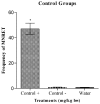Assessment of the in vivo genotoxicity of new lead compounds to treat sickle cell disease
- PMID: 21471937
- PMCID: PMC6260610
- DOI: 10.3390/molecules16042982
Assessment of the in vivo genotoxicity of new lead compounds to treat sickle cell disease
Abstract
The compounds 1,3-dioxo-1,3-dihydro-2H-isoindol-2-yl)methyl nitrate (C1), (1,3-dioxo-1,3-dihydro-2H-isoindol-2-yl)ethyl nitrate (C2), 3-(1,3-dioxo-1,3-dihydro-2H-isoindol-2-yl)benzyl nitrate (C3), 4-(1,3-dioxo-1,3-dihydro-2H-isoindol-2-yl)-N-hydroxy-benzenesulfonamide (C4), 4-(1,3-dioxo-1,3-dihydro-2H-isoindol-2-yl)benzyl nitrate (C5), and 2-[4-(1,3-dioxo-1,3-dihydro-2H-isoindol-2-yl)phenyl]ethyl nitrate (C6) were evaluated with a micronucleus test using mouse peripheral blood to identify new candidate drugs for the treatment of sickle cell disease (SCD) that are safer than hydroxyurea. The compounds induced an average frequency of micronucleated reticulocytes (MNRET) of less than six per 1,000 cells at 12.5, 25, 50, and 100 mg/kg, whereas hydroxyurea induced an average MNRET frequency of 7.8, 9.8, 15, and 33.7 per 1000 cells respectively, at the same concentrations. Compounds C1-C6 are new non-genotoxic in vivo candidate drugs for the treatment of SCD symptoms.
Figures



Similar articles
-
Mutagenicity of new lead compounds to treat sickle cell disease symptoms in a Salmonella/microsome assay.Int J Mol Sci. 2010 Feb 25;11(2):779-88. doi: 10.3390/ijms11020779. Int J Mol Sci. 2010. PMID: 20386668 Free PMC article.
-
Evaluation of hydroxyurea genotoxicity in patients with sickle cell disease.Einstein (Sao Paulo). 2019 Sep 9;17(4):eAO4742. doi: 10.31744/einstein_journal/2019AO4742. Einstein (Sao Paulo). 2019. PMID: 31508660 Free PMC article. Clinical Trial.
-
Synthesis, in vivo and in silico anticonvulsant activity studies of new derivatives of 2-(2,4-dioxo-1,4-dihydroquinazolin-3(2H)-yl)acetamide.Eur J Med Chem. 2019 Oct 15;180:134-142. doi: 10.1016/j.ejmech.2019.06.085. Epub 2019 Jul 2. Eur J Med Chem. 2019. PMID: 31302446
-
Hydroxyurea for children with sickle cell disease in sub-Saharan Africa: A summary of the evidence, opportunities, and challenges.Pharmacotherapy. 2023 May;43(5):430-441. doi: 10.1002/phar.2792. Epub 2023 Mar 26. Pharmacotherapy. 2023. PMID: 36906823 Review.
-
Hydroxyurea therapy contributes to infertility in adult men with sickle cell disease: a review.Expert Rev Hematol. 2014 Dec;7(6):767-73. doi: 10.1586/17474086.2014.959922. Epub 2014 Sep 22. Expert Rev Hematol. 2014. PMID: 25242414 Review.
References
-
- Hanft V.N., Fruchtman S.R., Pickens C.V., Rosse W.F., Howard T.A., Ware R.E. Acquired DNA mutations associated with in vivo hydroxyurea exposure. Blood. 2000;95:3589–3593. - PubMed
Publication types
MeSH terms
Substances
LinkOut - more resources
Full Text Sources
Medical
Miscellaneous

